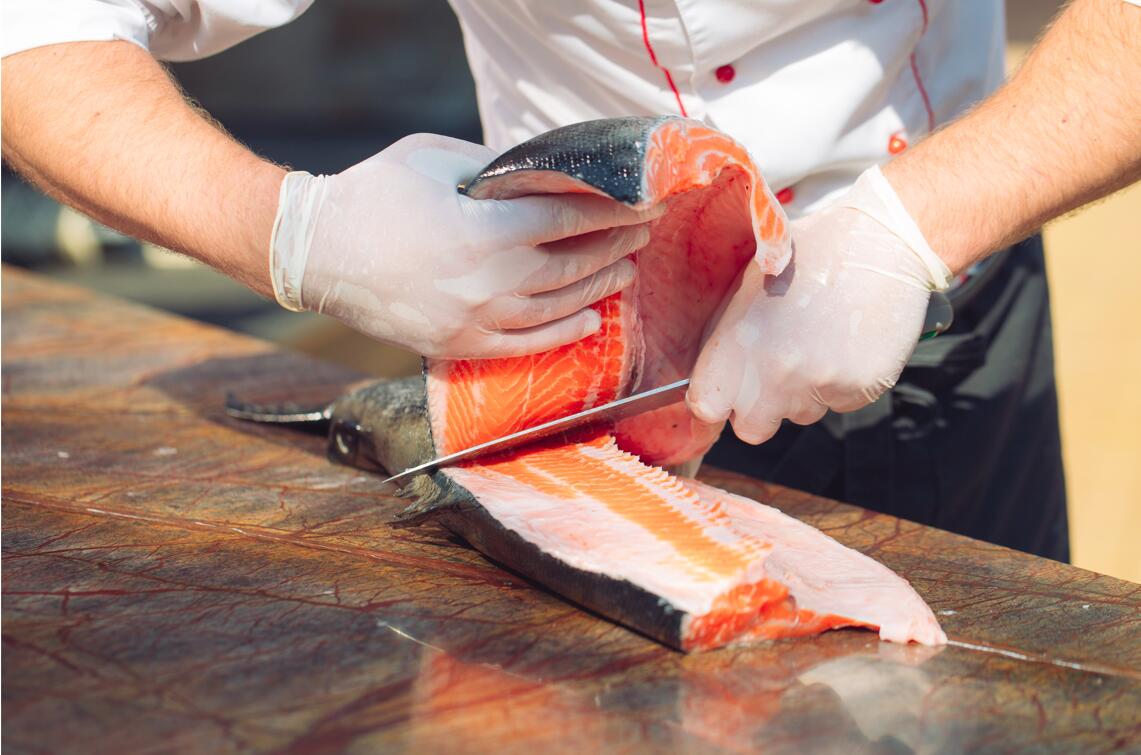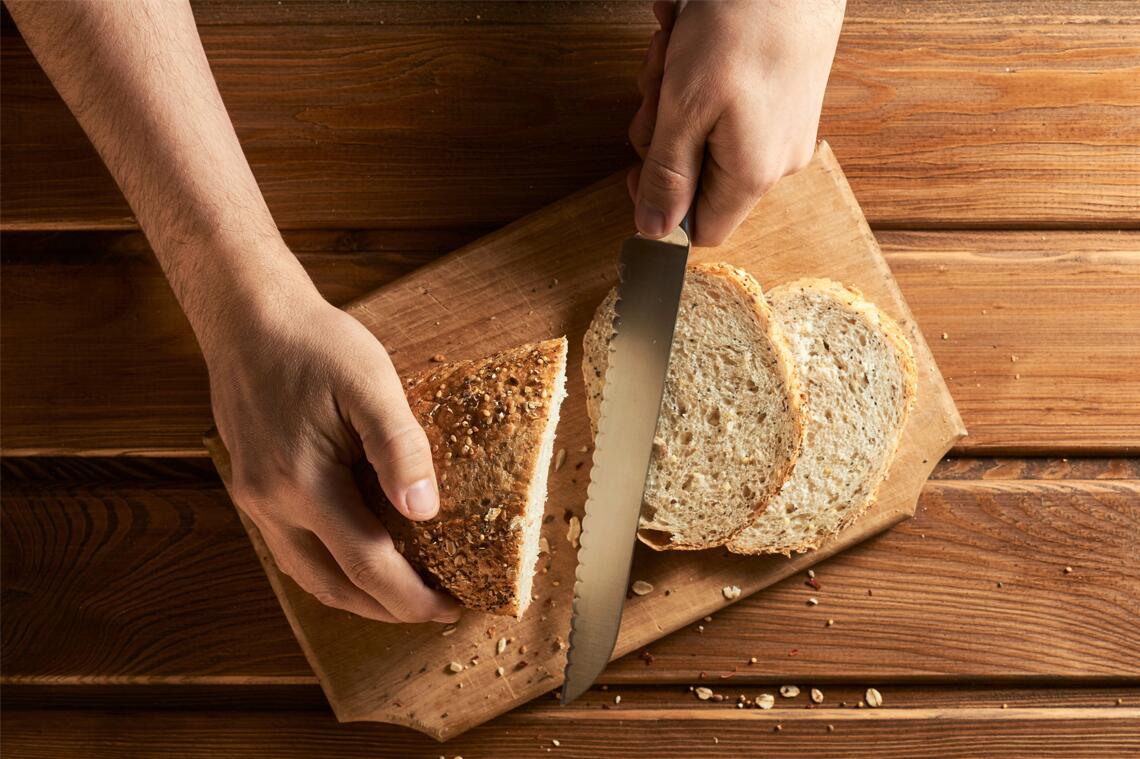In a world where most are right-handed, some tools and products don’t go well with left-handed people. This applies to specific types of kitchen knives as well. Sure, you might use some cutlery like scissors for the right-handed easily as a leftie, but it doesn’t mean you’ll have the same comfort with a kitchen knife.
Using a kitchen knife for the right-handed as a leftie can ruin both the ingredients you’re cutting and the blade itself. It’s crucial to know the knife you’re utilizing to have an easier time. In this article, we’ll cover everything you need to know about left-handed kitchen knives, how they are different, and reveal whether or not you should look for such knives.
Table of contents
Distinction between right and left-handed knives
Firstly, the differences aren’t as apparent in all knives. Only single bevel kitchen knives have a distinction for left and right-hand use. The Japanese specialty knives like the Yanagiba and Deba have a single bevel edge. This means the cutting edge on the blade is formed only on one side of the blade, whereas the other is flat or concave ground for better food separation.
Considering most people are right-handed also in Japan, most single bevel knives are ground on the side that favor use in the right hand. If the cutting edge is formed on the left and the other is flat, it’s for the right-handed. If it’s the other way around, it’s for lefties.
How does single and double bevel knives work?
To better understand what makes a kitchen knife left or right-handed, we first need to look at how these different cutting edges perform.
The single and double bevel knives don’t cut the same way. Because the cutting edge is a lot like a V in double bevel edge knives, the cutting edge is at the center of the blade and doesn’t require a specific cutting angle. You can cut ingredients from left to right or the other way around, and it won’t make any difference.
With single bevel edge knives, however, it requires the user to cut at a particular angle. Otherwise, the angle becomes too steep. This can tear the ingredient as you cut and damage the blade’s edge. For example, the double edge knife will slice an apple straight. As you move the knife through the apple, the blade will push the fruit on both sides, resulting in an even cut.
On the other hand, with a single bevel edge knife, the knife will steer toward the flat side of the blade. Although this isn’t advantageous in most kitchen tasks, it comes in handy when filleting or thinly slicing ingredients.
How do left-handed knives work?

Let’s clear something first. The cutting angle doesn’t matter in double bevel kitchen knives, at least not as much as single bevel alternatives.
In a way, you can think of double bevel knives to be ambidexter tools, providing equal function in both hands.
The difference in single bevel knives for lefties is the edge is formed on the opposite side. Although a minor difference, it entirely changes how you cut with the knife. Other than this, there isn’t a difference.
Just like a right-handed single bevel Japanese knife will give you problems when using it with your left hand, the direction in which you move the blade can also be problematic. Moving a right-handed blade in your right hand as if it was in your left can result in tearing the food or damaging the edge. That’s why Japanese knives require experience and understanding of the cutting angle – more on that below.
How to choose left-handed knives?
If you’re planning on purchasing a single bevel knife, you need to pay attention to where the cutting edge is formed. Typically, single bevel knives have their edge ground on the left side, making them better for right-hand use. As someone left-handed, you need to look for single bevel edge knives ground on the right side.
There isn’t a distinction in double bevel edge knives, but manufacturers can sometimes alter it slightly. Rather than forming the edge 50/50 on both sides, it can have a bias – say 60 on the left and 40 on the right. This favors the use in one hand more than the other. That said, even with double bevel knives, you may run into problems. Make sure the edge is formed symmetrically on both sides or favors the use in the left hand.
Using a right-handed single bevel knife with the left hand (or vice versa)
Suppose you bought a right-handed Yanagiba, but you’re a leftie. The angle will become too steep as you cut with the blade, whether you’re slicing or filleting fish. The outcome of this is ripping the meat apart as it’s lifted more than you hope for, not giving a clean slice.
Even if you hold the knife with the correct hand, the same will happen when you cut in the wrong direction. These specialty kitchen knives are designed to cut from left to right if you’re right-handed or in the other order if you’re left-handed. Operating the knife with this in mind will allow you to get the most out of the blade and result in beautiful cuts.
Should I choose a single bevel or double bevel knife?
Both single and double bevel knives have their uses. Due to the edge, single bevel knives are somewhat limited, but you can’t get the same specific results with a double bevel knife. For example, the chances are you won’t be able to slice fish as thinly with a double bevel knife as you could with a single bevel alternative.
Single bevel kitchen knives have a sharper edge. This perk makes them excellent at thinly slicing any ingredient. You can perform much of the tasks you’d do with a single bevel knife utilizing a double bevel knife but not as efficient. That’s why these kitchen knives are more for professional chefs that prepare foods on a commercial level.
Left-handed or not, you should always buy a knife that will treat you right. Consider that not all Japanese knives are single beveled. The multi-purpose options like Santoku and Gyuto have a double bevel, like western chef’s knives. If you fillet or prepare meals that often require thin animal protein slices, specialized Japanese knives will undoubtedly be a better option. In that case, you’ll need to look for a left-handed Yanagiba, Deba, or another knife that will suit the job.
If not, and you’re a home cook, you’re most likely better off with a double bevel all-purpose knife.
Not sure? Go with ambidextrous knives
Not all knives ground on both sides to construct the edge are for both hands. Some kitchen knives are ground asymmetrically to create the cutting edge for better use in one hand.
Ambidextrous or ambidexter knives have a symmetrical blade profile that favors use at all angles. The hand you hold the knife doesn’t matter as the edge is equally ground on both sides. These kitchen knives include knives with a V, convex, compound, and hollow ground edges. However, not all knives with these types of edges are ambidextrous. As mentioned above, they might be grounded more on one side than the other. Keep this in mind when making your purchase.
Recommended ambidextrous knives
True cutting power in the palm of your hand
Serrated knives

Much of the things discussed throughout this article also apply to knives with a serrated edge, like bread knives. The same as other kitchen knives, most serrated knives have their serration on the left side. As you cut, the position of the serrations counteracts the inward push that occurs naturally. Since inward means to the left as you’re holding the blade in your right hand, this poses a problem to lefties.
Look for a left-handed serrated knife like other kitchen knives that you use for chopping and slicing ingredients. The serrations should be on the right side of the blade as opposed to the left found in right-handed options.
Finding the right cutting angle
Take filleting as an example. When you move the blade between the bone and meat, it should slide easily. This is achieved by filleting in accordance with the knife’s cutting angle. The side that’s ground to create the edge should contact the bone, sort of lay flat to guide and easily glide the blade to the end.
This is not a problem with double bevel knives as both sides form the cutting edge. With single bevel edge knives, you must pay attention to the edge. As mentioned throughout the article, cutting at the wrong angle can tear the meat and create unnecessary tension at the edge, risking chipping or other damage to the blade.
When cutting ingredients vertically, the angle won’t matter as much, but the ground side should be on the right when doing intricate work like thinly slicing boneless animal protein. Even trying and cutting foods at different angles can help you find the correct cutting angle. Nonetheless, the side forming the edge should fall on the opposite side you’re moving the blade as a general rule of thumb.
Take a closer look at your knife, and you’ll see where it’s ground. If not sure, run your finger from the blade’s spine to the edge. You’ll feel where it begins to get thinner. This side of the blade should always face the right direction, not only for clean cuts and to protect the knife but also for better food separation.
Ending
Utilizing a left-handed knife gives you perfectly sliced and cut ingredients. If you’ve been using right-handed knives all your life, transitioning to a dedicated blade for lefties will ultimately give you cleaner results. You’ll be shocked at how easy it is to work with the knife.
We highly suggest getting yourself a pair for left-hand use or an ambidextrous one. Shop at our collection and read more on kitchen knives on our blog.












